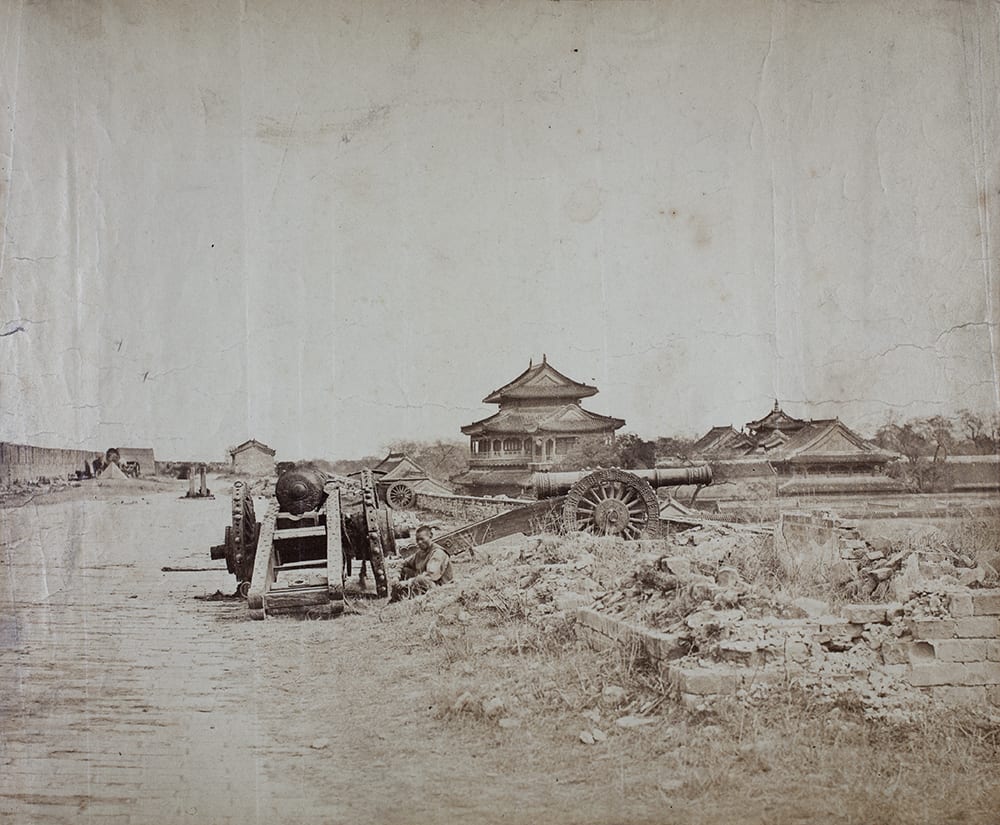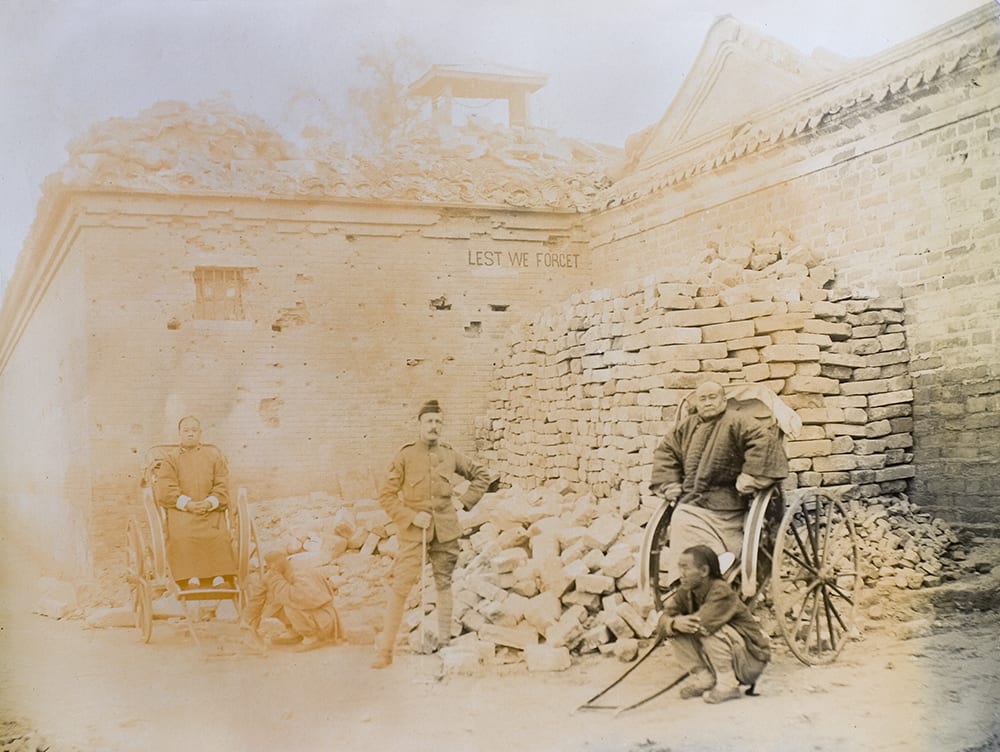In the first of two blogs, Dr Andrew Hillier introduces a new Historical Photographs of China initiative – the Regimental Museums Project – which he is coordinating, and which will draw on photographs in regimental and national collections, to explore both Britain’s military presence in China and their wider social and cultural significance.
Many would agree with Margery Masterson that ‘the army … remains largely absent from social and cultural histories of Victorian Britain and her empire.’ [1] Whatever the reasons, including, perhaps, a latent distaste for military imperialism, it means that a rich vein of material in regimental and national archives is at risk of being over-looked by historians. Moreover, as museums holding these archives face significant challenges, a number are finding it increasingly difficult to make the collections accessible, both to professional historians and the general public. There is a wealth of photographs illustrating the British military presence in China but, whilst some of these can be found on Historical Photographs of China, this represents only a tiny fraction of what is potentially available.
Supported by the Army Museums Ogilby Trust (AMOT) and a generous grant from the Swire Foundation, Historical Photographs of China (HPC) is launching a project that will seek to make that material better-known and more accessible to a wider public and bring out the social and cultural implications of that presence both in and outside the combat zone. By creating links with such collections, digitising and up-loading images on the HPC web-site, where feasible, and hosting introductory blogs, the project is designed to stimulate interest in, and debate about, Britain’s presence in China and this aspect of its past more generally, as well as providing sometimes rare and distinctive views of China and Sino-foreign encounters. In this blog, I will set the scene with the introduction of military photography to China and its early uses.
The Second Opium War (1856-1860) was the first military campaign in China to be successfully captured in photographs. Felix Beato, who had already built his reputation in the Crimea, arrived in Hong Kong as the war was entering its final phase and went on to produce outstanding images of its brutality and waste. [2] Published as engravings in newspapers and journals, copies of these photographs could also be purchased in China and later in London, and some examples, now extremely valuable, can still be found in the archives of regiments that took part in the conflict.

Chinese Artillery on Peking City Walls, October 1860. Photograph by Felice Beato. The 67th (South Hants) Regiment of Foot played a major part in the final stages of the attack on Peking. This photograph is in the Royal Hampshire Regiment Museum’s archives and must have been purchased in the 1860s by someone in the regiment [3]
Officers also started taking and acquiring pictures for their personal use and having their likenesses recorded in cartes de visite: these would be enclosed in letters home or pasted into albums, which can still be found in regimental archives.[7] Some of these were taken in commercial photography studios that were starting to be established in China. John Thomson (1837-1921), who spent four years in Hong Kong, with extended visits to Peking (Beijing), Fujian, along the Yangzi, and Guangdong from 1868 until 1872, was perhaps the most celebrated of these early photographers. Coinciding with the work of Dr John Dudgeon (1837-1901), who published the first treatise on photography to be written in Chinese, by the late 1870s, photography had become a thriving commercial enterprise for western and Chinese studios in treaty port China and Hong Kong.[8] Ten years later, with the introduction of the dry-plate gelatin process and the Kodak ‘point and shoot’ camera, ‘instant photography’ had also become a popular past-time for amateurs.[9]
It is not surprising, therefore, that Britain’s military presence in China from 1856 until its final withdrawal in the 1940s, was extensively photographed by members of the armed forces, newspaper correspondents and civilians. [10] Undoubtedly, at times it could be used as a powerful mechanism of imperialism, the triumphalist and brutal imagery of the Boxer Uprising and War being a prime example.[11]

A damaged corner of the British Legation, Peking (Beijing), c.1901, with LEST WE FORGET inscribed on the wall. Photograph by the Photo Section of the British Corps of Royal Engineers, from an album (WO 28/302. China. Boxer Rebellion) in the National Archives. Crown copyright image reproduced by permission of The National Archives, London, England.
However, as we will see in the next blog, many of these regimental collections also reflect a more nuanced aspect to the military presence, showing how photography could stimulate interest in China and its culture and facilitate interaction with the Chinese people outside the combat zone. [12]
NOTES
[1] Margery Masterson, ‘Besmirching Britannia’s Good Name: Army Scandals in Mid-Victorian Britain’: Unpublished Ph. D. dissertation, University of Bristol, 2012, p.22 and the works there cited.
[2] A selection of Beatos’ images can be found on the HPC platform; see also Jeffrey Cody and Frances W. Terpak (eds), Brush & Shutter: early photography in China (Los Angeles: Getty Research Institute), 2011.
[3] See my earlier blog on this.
[4] James R. Ryan, Picturing Empire: Photography and the Visualization of the British Empire (London: Reaktion Books Ltd, 1997), p.73.
[5] For the Second Opium War, including the Royal Engineers photographers, see Terry Bennett, History of Photography in China, 1842-1860 (London: Quaritch, 2009), pp.81-122. For Papillon, see John Falconer, ‘John Ashton Papillon: An amateur photographer in China, 1858-1860’, Photographic Collector, 3, no. 3, 1982, p.353. The on-line catalogue of the Royal Engineers Museum Library and Archive (REMLA) has a thumbnail image and detailed notes in relation to each photograph: to see these follow this link; REMLA 6.1: ‘Photographs taken in China during the years, 1858, 59 & 60 by Lieut. J.A. Papillon Album’.
[6] Capt. William de Wiveslie Abney, RE, Instruction in Photography: For Use at the SME Chatham (Chatham, 1871); a later version ran into eleven editions.
[7] On regimental cartes de visite see my earlier blog.
[8] See Terry Bennett, History of Photography in China, 1842-1860 (London: Quaritch, 2009); Bennett, History of Photography in China: Western Photographs, 1861-1879 (London: Quaritch, 2010); for Thomson, see pp. 214-256 and for Dudgeon, pp.37-55; Bennett, History of Photography in China: Chinese Photographers, 1844-1879 (London: Quaritch, 2013). See also Betty Yao (ed), China Through the Lens of John Thomson 1869-1872 (London: River Books, 2015).
[9] See my blog ‘The Kodak comes to Peking‘, and Falconer, Western Eyes: Photographs of China in Western Collections, 1860-1930, (Beijing 2008).
[10] For details of the regiments that were stationed in China and Hong Kong during this period, see A.J. Harfield, British and Indian Armies on the China Coast 1840 – 1985 (London: A & J Partnership, 1990), pp. 485-492.
[11] Cf. James Hevia, English Lessons: The pedagogy of imperialism in nineteenth-century China (Durham, N.C.: Duke University Press, 2003), pp. 260-281.
[12] See Robert Bickers, ‘The Lives and Deaths of Photographs in China’ in Christian Henriot and Weh–hsiu Yeh (eds), Visualising China, 1845 -1965: Moving and Still Images in Historical Narratives (Leiden: Brill, 2012), pp.3-38.
